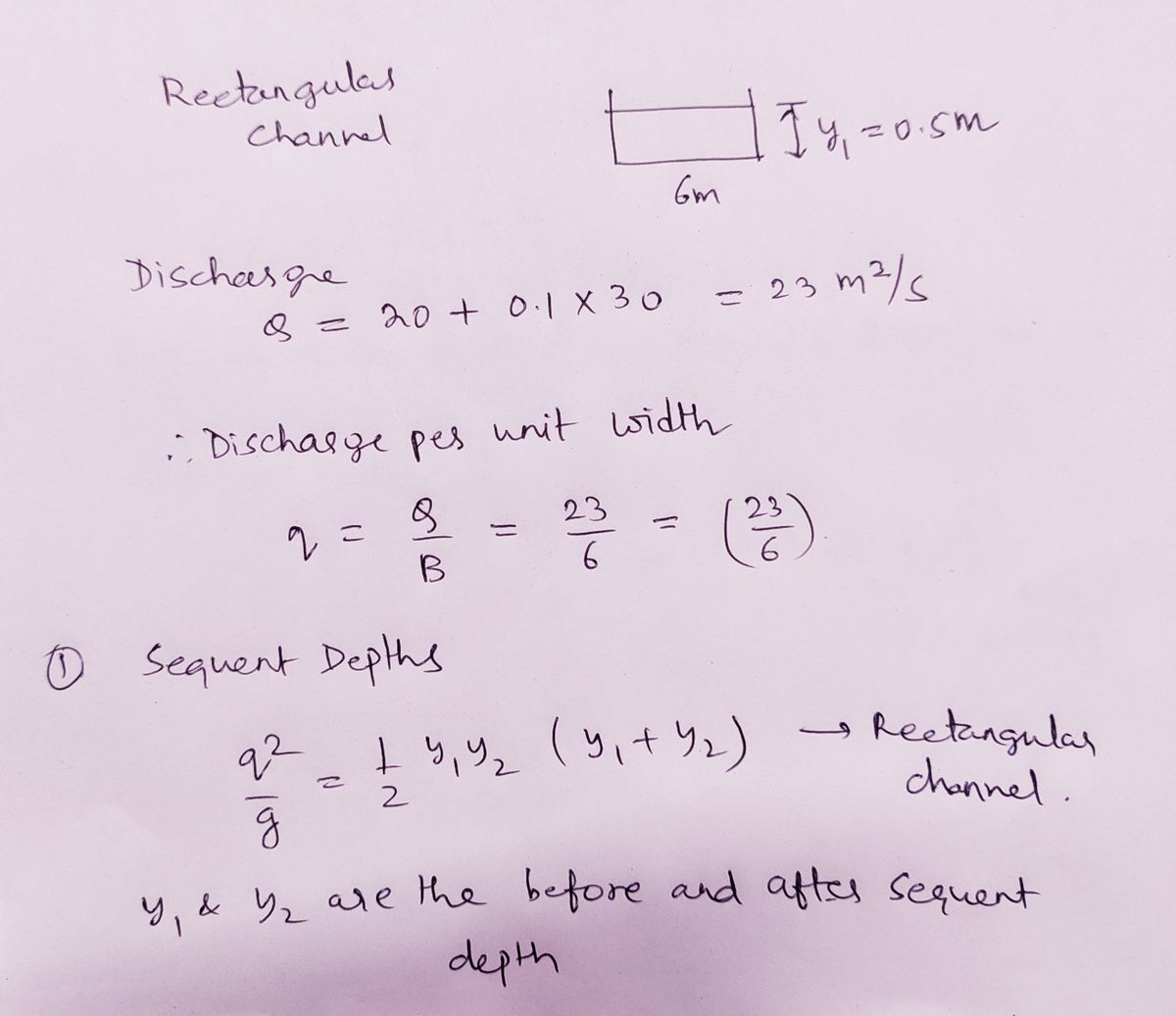fuði- þir. - A hydraulic jump occurs in a 6 m wide rectangular channel at initial flow depth of 0.50 m. The discharge through the channel is 20 + (0.1* last two digits of your student ID) m³/s. If the Jump is type C with angle [10 + (0.01* last two digits of your student ID)] degree, determine the i) downstream (sequent depth) after the jump and ii) energy loss of the jump.
fuði- þir. - A hydraulic jump occurs in a 6 m wide rectangular channel at initial flow depth of 0.50 m. The discharge through the channel is 20 + (0.1* last two digits of your student ID) m³/s. If the Jump is type C with angle [10 + (0.01* last two digits of your student ID)] degree, determine the i) downstream (sequent depth) after the jump and ii) energy loss of the jump.
Chapter2: Loads On Structures
Section: Chapter Questions
Problem 1P
Related questions
Question
100%
Last two digit =30
![**Hydraulic Jump Analysis in a Rectangular Channel**
A hydraulic jump occurs in a rectangular channel that is 6 meters wide. The initial flow depth is 0.50 meters. The discharge through the channel is calculated using the formula:
\[ \text{Discharge} = 20 + (0.1 \times \text{last two digits of your student ID}) \, \text{m}^3/\text{s}. \]
If the jump is type C with an angle calculated as:
\[ \text{Angle} = 10 + (0.01 \times \text{last two digits of your student ID}) \, \text{degree}, \]
determine the following:
i) **Downstream (Sequent) Depth:** Calculate the depth of water after the jump.
ii) **Energy Loss of the Jump:** Determine the energy dissipated as a result of the jump.
**Note:** Substitute the specific numerical values based on your student ID to compute the actual discharge and angle values. This exercise will help in understanding the application of hydraulic jumps in engineering contexts.](/v2/_next/image?url=https%3A%2F%2Fcontent.bartleby.com%2Fqna-images%2Fquestion%2F6ed10701-11d4-4f91-a002-bcccc493de78%2Ff44263af-a654-4615-a2a5-3c8a95496688%2F8cfvpbm_processed.jpeg&w=3840&q=75)
Transcribed Image Text:**Hydraulic Jump Analysis in a Rectangular Channel**
A hydraulic jump occurs in a rectangular channel that is 6 meters wide. The initial flow depth is 0.50 meters. The discharge through the channel is calculated using the formula:
\[ \text{Discharge} = 20 + (0.1 \times \text{last two digits of your student ID}) \, \text{m}^3/\text{s}. \]
If the jump is type C with an angle calculated as:
\[ \text{Angle} = 10 + (0.01 \times \text{last two digits of your student ID}) \, \text{degree}, \]
determine the following:
i) **Downstream (Sequent) Depth:** Calculate the depth of water after the jump.
ii) **Energy Loss of the Jump:** Determine the energy dissipated as a result of the jump.
**Note:** Substitute the specific numerical values based on your student ID to compute the actual discharge and angle values. This exercise will help in understanding the application of hydraulic jumps in engineering contexts.
Expert Solution
Step 1

Step by step
Solved in 2 steps with 2 images

Recommended textbooks for you


Structural Analysis (10th Edition)
Civil Engineering
ISBN:
9780134610672
Author:
Russell C. Hibbeler
Publisher:
PEARSON

Principles of Foundation Engineering (MindTap Cou…
Civil Engineering
ISBN:
9781337705028
Author:
Braja M. Das, Nagaratnam Sivakugan
Publisher:
Cengage Learning


Structural Analysis (10th Edition)
Civil Engineering
ISBN:
9780134610672
Author:
Russell C. Hibbeler
Publisher:
PEARSON

Principles of Foundation Engineering (MindTap Cou…
Civil Engineering
ISBN:
9781337705028
Author:
Braja M. Das, Nagaratnam Sivakugan
Publisher:
Cengage Learning

Fundamentals of Structural Analysis
Civil Engineering
ISBN:
9780073398006
Author:
Kenneth M. Leet Emeritus, Chia-Ming Uang, Joel Lanning
Publisher:
McGraw-Hill Education


Traffic and Highway Engineering
Civil Engineering
ISBN:
9781305156241
Author:
Garber, Nicholas J.
Publisher:
Cengage Learning